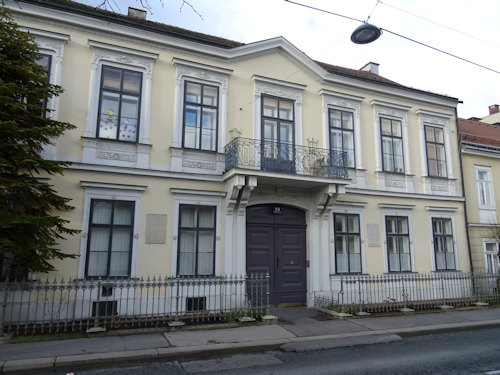
Chalk up another tick on the musical experience checklist. This unassuming house provided a home for one of Vienna’s great musical sons and great musical creations: Johann Strauss II and Die Fledermaus operetta.
- Strauss lived and composed here from 1870 – 1878
- Plaque outside explains the Strauss connection
- A private house, so can only be viewed from the street
- Book a concert experience* for Vienna
- See also:
Die Fledermaus

(The original building still stands here)
Visit the unassuming two-storey house on Vienna’s Maxingstraße and a small plaque hints at its musical past. Here’s my translation of the text:
Johann Strauss lived in this house (which was his own) from 1870 to 1878 and wrote his immortal “Die Fledermaus” here.
Wiener Schubertbund 1934
(The Wiener Schubertbund is the Vienna Schubert Association, founded in 1863 and still going strong today.)
By 1870, Strauss already enjoyed celebrity status, and had recently given concerts in both Paris and London.
In the next decade, he turned his hand to operettas with the not inconsiderable help of the Prussian-born librettist, Richard Genée. A number of pieces emerged while Strauss lived on Maxingstraße, including his most famous work in that genre: Die Fledermaus.
The premiere took place in 1874 at the Theater an der Wien, beginning the long association between Vienna and this operetta.
Initial reviews, however, did little to hint at the long-term success of the piece. For example, a rather unimpressed writer in the Express weekly newspaper of April 7th, 1874, ended their article so (my translation):
The “Fledermaus” will have flapped its last wings soon
Today, Vienna’s State Opera House traditionally performs Die Fledermaus on New Year’s Eve, with a live broadcast on a giant screen on the square outside the building for revellers to enjoy.

(Jani Szika as the character Eisenstein in Die Fledermaus, photographed by Julius Gertinger in 1874; Szika was the first actor to play the role; Wien Museum Inv.-Nr. 108257/39; excerpt reproduced with permission under the terms of the CC0 licence)
The overture remains one of classical music’s most recognisable and even featured memorably in the 1950 cartoon, Tom and Jerry in the Hollywood Bowl.
Unfortunately, the house that gave birth to Die Fledermaus is in private hands, so you can’t look around. But pictures are easily taken from across the road.
Curiously, Johann Strauss is not the only famous former resident here.
According to another plaque on the house exterior, the painter Julius Schmid (1854–1935) lived here between 1898 and 1925.
In tandem with the musical theme, Schmid is known for his paintings featuring Beethoven and Schubert. His 1897 Eine Schubertiade, for example, features the latter performing at the piano at a private house concert.

(The Strauss plaque)
The same plaque also claims the composer Carl Prohaska (1869 – 1927) lived in the house from 1911 until his death.
How to get to the Fledermaus House
The house sits on Maxingstraße, a road that travels up the western edge of the Schönbrunn park area. The Hietzing subway station (U4) is quite close, so you can walk up from there.
Carry on past the house to find a little side entrance to the botanic gardens part of Schönbrunn park. If it’s closed, then you need to walk back down toward Hietzing station to find the main entrance to the park that also leads to the palace proper and the zoo.
Walk even further up Maxingstraße to discover Hietzing cemetery and the last resting place of Strauss’s first wife, Henriette, and his sisters, Theresia and Anna. The same cemetery contains the graves of the artist, Gustav Klimt, and the architect and designer, Otto Wagner.
Address: Maxingstraße 18, 1130 Vienna